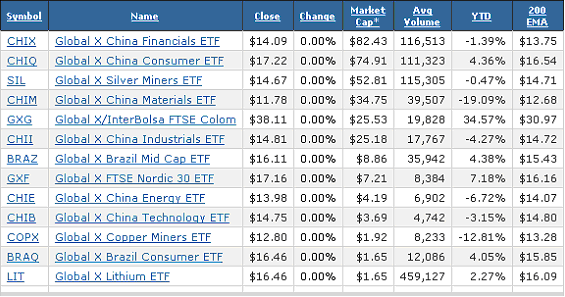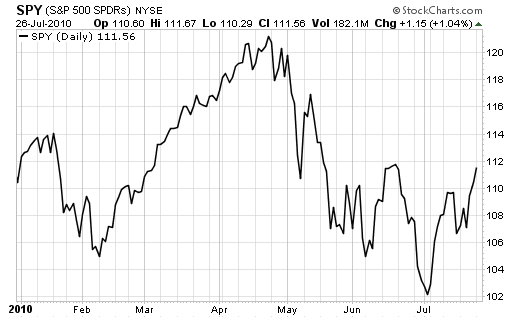- Theory vs. Practice
- .07% gains from these ETFs
- Why expense fees matter – big time
-
The one sector that’s defying
expectations
On paper, I love socialism, the United Nations and ETFs. On
paper, socialism is paradise where we all take equal advantage of each other
and enjoy the fruits of the world’s labor for free! The UN is the friendly
world-policeman making sure that no one shoplifts or performs acts of
mass-genocide, and ETFs are easy, convenient baskets of investments that
every day investors can choose from to match their needs.
But in practice,
all three are about as bad as it gets. Socialism is responsible for more
death and destruction than any other form of government. The UN is an
ineffectual collection of world improvers who can’t manage to do the simplest
of things right. And ETFs are baskets of investments typically launched at
the peak of their popularity, which as we know, is the worst time to buy any
investment.
So whenever I see a new commodity ETF coming over the
horizon, my first instinct is to short it, if not completely ignore
it.
Of course there are exceptions, and for the morbidly
curious, I’m putting together a report about the ONLY three commodity ETFs
that I like. It will be available sometime in the next week or so. Watch your
inboxes.
In the meantime, let’s look at one group of ETFs launched by
one firm – most of these are based on commodities.
Below, I’ve posted a table of ETFs launched by Global X
Funds.
If you haven’t heard of Global X Funds, that’s because
they’re relatively late to the ETF party. They launched their first ETF in
2009.
Year to date, their
13 ETFs have gained .07% on average.
That’s almost exactly in-line with the broad market, which
is up 1.04% over the same period, so you can’t fault them there.
Unfortunately, you don’t have to pay an expense fee of 0.5% to 0.86% for
buying the broad market, like you do with Global X Funds’ ETFs.
The most commonly used broad market ETF is Standard
and Poor’s Depositary Receipt (NYSE: SPY). This ETF does one thing:
it tracks the S&P 500 index. It’s the easiest, and one of the cheapest
ways to buy the stock market. This ETF only charges a .09%
expense fee.
Once you subtract
out the expense fees, the broad market ETF is beating Global X Funds’ ETFs by
a significant margin – because with an average expense fee of .67%, that puts
the Global X ETFs into the negative by over half a percentage point.
After SPY’s expense fee, it’s still in the positive by
nearly one percent. That doesn’t sound like that much of a big deal, but it’s
these small differences that can make or break your portfolio. It’s the
difference between losing money and compounding your wealth.
One percent growth every eight months will turn a $1,000
investment into $1,160 in ten years.
But if you’re losing half a percent every eight months, that
turns $1,000 into $927.56 after ten years.
Now, I’m not telling you to go out and buy the broad market
just yet. My point is that if you want to be invested in commodities, you
should be wary of ETFs.
Take a look at this table of four of the most common oil
ETFs. Sine January 31, 2007, oil prices rose 37% – but none of these ETFs
have managed to keep pace, and only one of them is in the black for that
period:
|
Fund |
Symbol |
Return |
|
US Oil Fund |
USO |
-26% |
|
PS Ultra Oil and Gas |
DIG |
-52% |
|
iPath S&P GSCI Oil |
OIL |
-35% |
|
PS DB MultiSelect Oil |
DBO |
6% |
|
|
Average |
-26.75% |
It’s not enough to be right on the trend. You have to be
right on the specific investment within that trend.
When it comes to ETFs, you’re best bet is to short new ETFs.
Yeah, you still have to pay the expense fee, but at least you’re paying that
fee for the privilege of making money, not for owning the new hot
investment.
If you don’t feel comfortable shorting, then my best
recommendation is to avoid ETFs altogether UNLESS you absolutely understand
how they work – including whether or not they’re involved in buying futures.
And for any investment, make sure you understand the cost structure. Some
ETFs charge as much as .9% expense fees – which is a huge fee for a fund
that, by definition, is not actively managed.
I know I’m down on
the broad market, but there is one sector that appears to be defying
expectations.
I’m talking about technology. Right now, tech’s bull market
is something of a secret. Most tech companies are trouncing earnings
expectations – and why not? America’s top firms for the past two decades have
almost always been involved in technology. Ian Wyatt, my boss and Chief
Investment Strategist here at Wyatt Research recently put together a special
report all about his three favorite technology stocks. It’s called
“The
Secret Economic Recovery, 3 Tech Stocks Leading the
Way.”
If you’re interested in learning about three companies that
are the current exception to the recession, I invite
you to click here to read Ian’s full write-up on these three
companies.
Good investing,
Kevin McElroy
Editor
Resource Prospector
disclosure: no positions
 Facebook
Facebook
 Twitter
Twitter

